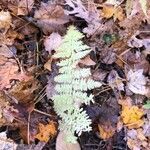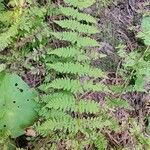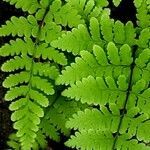Stems creeping, not cordlike, internodes very short, less than 0.5 cm, heavily beset with old petiole bases, hairs absent; scales uniformly brown to somewhat clathrate, lanceolate, radial walls brown, luminae clear. Leaves monomorphic, clustered at stem apex, to 75 cm, seasonally bearing sori (earliest leaves lack sori, subsequent leaves with sori). Petiole reddish when young, usually green or straw-colored throughout (occasionally darker) in mature specimens, shorter than blade, base sparsely scaly. Blade broadly to narrowly deltate, 2-pinnate to 2-pinnate-pinnatifid, almost always widest at base, apex long-attenuate; rachis and costae usually densely covered by unicellular, gland-tipped hairs, often with bulblets; axils of pinnae occasionally with multicellular, gland-tipped hairs. Pinnae mostly perpendicular to rachis, not curving toward blade apex, margins serrate; proximal pinnae pinnate-pinnatifid to pinnatifid, ± equilateral, basiscopic pinnules not enlarged, basal basiscopic pinnules sessile to short-stalked, bases truncate to obtuse; distal pinnae ovate to oblong. Veins directed into notches. Indusia cup-shaped, apex truncate, typically invested with unicellular, gland-tipped hairs. Spores spiny, usually 33--38 µm. 2 n = 84.
More
Larger and coarser than no. 1 [Cystopteris fragilis (L.) Bernh.] , the lvs 3–8(–15) dm, the blade 6–9 cm wide, with (15–)20–30 pairs of pinnae, the lowest pair a little larger than the next pair, the reduced upper pinnae more numerous than in no. 1, so that the lf tapers more gradually to the tip; rachis commonly with 1 or more well developed bulbils on the lower side beyond the middle, these to 4 or 5 mm; costae with scattered pale short-stalked glands; veins mostly ending in the smaller sinuses (reflecting an exaggeration of the tendency seen in some specimens of no. 1 for the principal teeth to be apically indented); indusium brownish, rounded or truncate at the tip, bearing scattered small, pale, short-stalked glands; 2n=84; otherwise much like no. 1 [Cystopteris fragilis (L.) Bernh.].
A fern. It grows 30-45 cm high and 20-30 cm wide. The fronds form swirling rosettes. They are light green and slender. The fronds are divided and have curved tips. Bulbils develop below the midribs. They are lightly tinged with red.
Shaded ravines, cracks and ledges on cliffs, rarely terrestrial; usually on calcareous substrates from sea level to 2500 metres.
More
It is frost hardy. It is lime tolerant. It often grows on moist shady rock faces. It suits hardiness zones 3-9.



